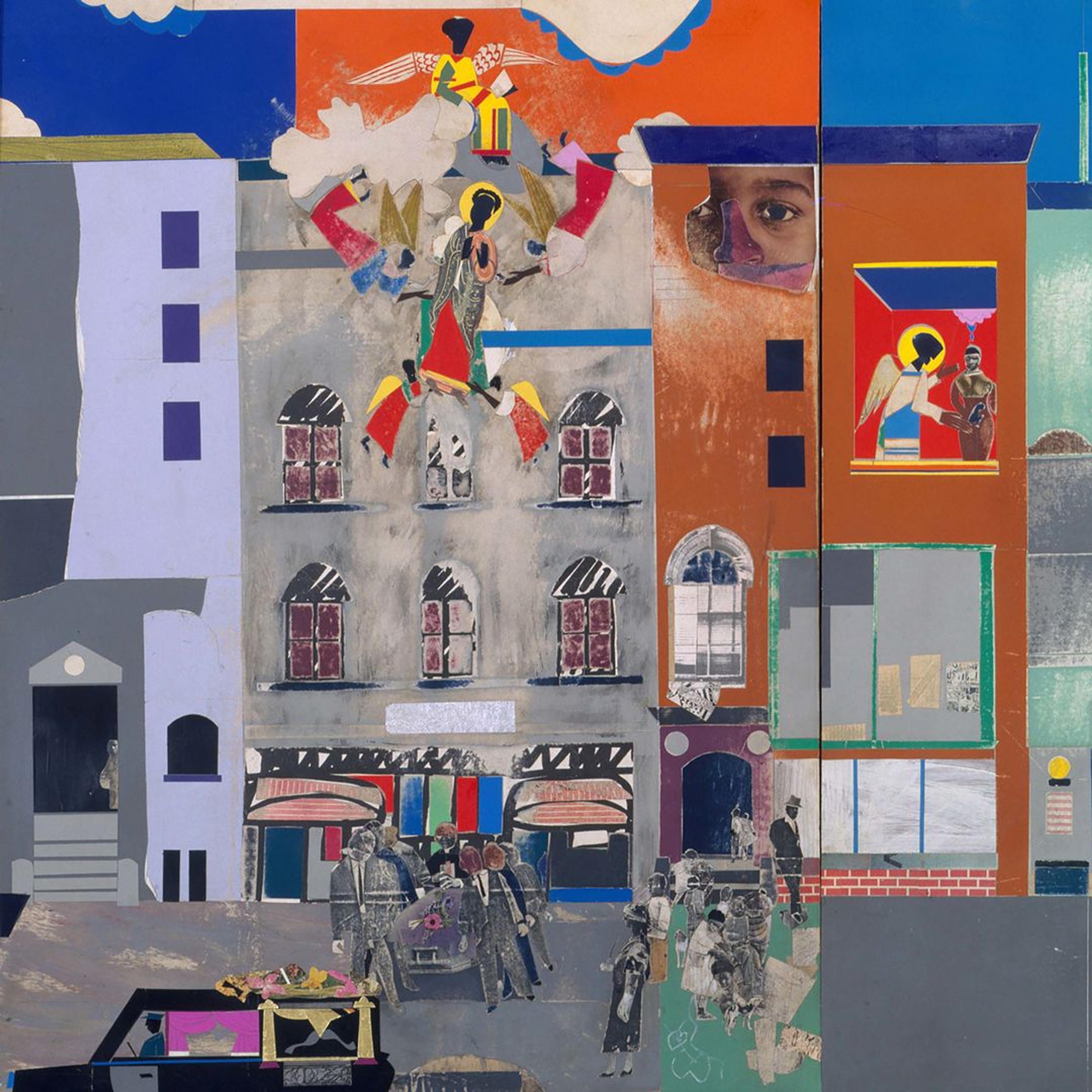Romare Bearden’s The Block (1971) is epic in its liveliness. There is much to take in; I find it difficult to view the entire mural at once. Although the activities portrayed on a Harlem street are stilled—a funeral procession, children at play, a couple embracing in bed, people convening in front of a storefront—thanks to the artist's vision, one feels life teeming from the mural-size collage. In that sense, the work seems to breathe its colors, visual allusions, and assembled figures. Wherever my eye roams, I am faced with some complex interplay between the sacred and profane. The work inspires reflection and a deep appreciation for the expanse of human activities in a relatively small area. Bearden collapses the distance between the private and public, and thus, forces me as a viewer to peer in, at some deeper level of knowing. I am startled by the intimacy the mural grants us. In his discussion with Albert Murray, Bearden speaks of The Block as a musical composition on par with a sonata. I hear, too, what is equally a feast for the ears as much as the eyes: honking cars, gospel music of the church, the music and banter in a barbershop, and surprisingly, the sereneness of the day coming to an end. The mural thrives. My poem attempts to honor the sweep of Bearden’s vision.

Romare Bearden (American, 1911–1988). The Block, 1971. Cut and pasted printed, colored and metallic papers, photostats, graphite, ink marker, gouache, watercolor, and ink on Masonite, 48 in. x 18 ft. (121.9 x 548.6 cm). The Metropolitan Museum of Art, New York, Gift of Mr. and Mrs. Samuel Shore, 1978 (1978.61.1-.6) Art © Romare Bearden Foundation/Licensed by VAGA, New York, NY
“The Block” by Major Jackson
for Romie
The Block
A village though, holy presence
in the bricks, to see through walls
with our eyes. Bodies assembled such that traffic
stays on the margins but the bright river,
though stilled on one Harlem avenue, flows out
from thresholds and doorways
where penny-colored faces profile like noble silhouettes,
and thus, this tension between life’s rush
and final doom. Someone has died,
and a hearse awaits, Bearden seems to say,
for us all, swimming with his mouth wide open.
No smirks from those enamored of the panorama.
To cross a corner, to sit sullen
on a staircase, to grasp a child from behind
weaves a cherished landscape of propositions.
A mother is half a Madonna,
and a blue bulb’s filament looms above the saints
of Sunrise Baptist whose hymns are unheard melodies,
whose prayer book, candle, altar
fix us to Southern roads. Why leave
when so much is here to observe?
The syncopated dailiness is Greek in proportions.
Even a barbershop serves a mirror,
all snips and shears and fades.
We, too, resurrect and ascend
and shake hands with Ethiopian angels,
and what carries the music
of our ascension is life, an improvised
resurrection, a colorful bricolage
of ritualistic seeing, tenements played
like keys, a communal blues, our imperative
for tenderness, lovemaking at dusk,
a billowing curtain serene as a kiss.
Here, there are no secrets.
These bodies in repose, bodies rising from
metal frame beds, bodies soaking in tubs,
bodies watching TVs as boats sail on,
children hovering above hopscotch squares,
what are they but the affirmative dream
of a city whose arrivants are dignity personified?
Look closer, look in:
animals are here, too.
A yellow pigeon coos on an awning,
another pair on a rooftop,
seagulls lift and angle into thermals,
a dalmatian stands beside a boy
as if in a Brueghel.
The tenements on Lenox between 132nd and 133rd
proclaim the flaneur’s feast: a mother calls down
from a window to remind her daughter
of ingredients for potato pone, pork belly, and cow peas.
At the corner store, a couple leans
against glass oblivious of the nearby crowd
seeming to convene a second line.
We are not without our vices
so says the neon Liquors sign
and the blanketed man who’s made concrete his bed.
Several floors above,
a mousetrap is a window
that wants to ambush a setting sun.
But the old folk from the fields
hold sentry like F. Douglass in portraiture,
and H. Tubman, and may we
revere them, may they occupy the periphery
of our vibrant canvases.
We are entangled in geometric shapes.
Our limbs are their limbs.
In cities, feelings pass through walls

Major Jackson
Author and Poet
Major Jackson is the author of six books of poetry, most recently, Razzle Dazzle: New & Selected Poems. His edited volumes include Best American Poetry 2019, Renga for Obama, and Library of America’s Countee Cullen: Collected Poems. A recipient of fellowships from the Academy of American Poets, John S. Guggenheim Foundation, National Endowment for the Arts, and the Radcliffe Institute for Advanced Study at Harvard University, Major Jackson has been awarded a Cave Canem Prize, a Whiting Writers’ Award, and has been honored by the Pew Fellowship in the Arts and the Witter Bynner Foundation in conjunction with the Library of Congress. He has published poems and essays in American Poetry Review, The New Yorker, Orion, The Paris Review, Poetry London, and World Literature Today. Major Jackson lives in Nashville, Tennessee, where he is the Gertrude Conaway Vanderbilt Chair in the Humanities at Vanderbilt University. He is an elected member of the American Academy of Arts and Sciences and serves as the poetry editor of Harvard Review.
